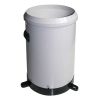KISTERS FCD Field Calibration Devices
Features
- Compact, light-weight, portable, packed in a robust carry case
- Corrosion-resistant (made of stainless steel, nickel silver and UV stabilized Delrin)
- No maintenance required
- Free ground shipping
- Expedited repair and warranty service
- Lifetime technical support
- More
Overview
The KISTERS Field Calibration Device (FCD) checks rain gauges in the field for accuracy. The portable, lightweight device effectively enables field technicians to run functional tests and verifications of any rain gauge in the field. The use of FCD saves time and money because the tipping bucket rain gauges can remain fixed in their location without the need for dismantling and transport and with very short downtimes for calibration only.
Mechanics
FCD checks whether a rain gauge is providing accurate readings: It discharges a certain volume of water into the rain gauge collector. Then, the number of tips has to be counted and checked with the calibration specifications.
Material
- Body: synthetic thermoplastic resin (polycarbonate)
- Nozzle: Delrin and nickel silver
- Vent: stainless steel
- Adaptor: Delrin
Capacity
- 653mL (used with TB3, TB4, TB6, TB7)
Nozzle
- 50mm/hr or 100mm/hr
Scope of Delivery
- One nozzle included
- Calibration specifications
- Carry case
In The News
Wildfire Prevention in the Sierra Nevada Region with the Yuba Watershed Institute
Though recent wildfires have sparked new conversations about wildfire management and response, groups like the Yuba Watershed Institute have been monitoring the forests and water resources of the Sierra Nevada region for decades, managing approximately 5,000 acres of land with the Bureau of Land Management (BLM) and about 7,000 acres in private land partnerships. The goal of the Institute is to work with local communities and land agencies to improve watershed and forestry management through informed practices and public outreach. The goals of the Yuba Watershed Institute are three-fold: Improve the ability of fire suppression agencies like the California Department of Forestry and Fire Protection ( CAL FIRE ) and the US Forest Service.
Read MoreWave Sensors Integration with NexSens Buoys: A Cutting-Edge Solution for Wave Measurment
Real-time wave data supports accurate weather prediction, safe and efficient maritime operations, and provides valuable safety and operating condition information for recreation and commercial fishing. Understanding wave dynamics also helps with the design of protective coastal structures like seawalls, breakwaters, and jetties. It also supports better prediction of their impact on sediment transport and coastal geomorphology. Wave data is a key factor in qualifying and designing offshore wind farms and harnessing kinetic energy for electrical generation. It helps with the understanding of ocean-atmosphere interactions and contributes to studies of sea-level rise and climate change impacts.
Read MoreSpring 2025 Environmental Monitor Available Now
In the Spring 2025 edition of the Environmental Monitor, we highlight partnerships across the world and the importance of collaboration between government agencies, universities, environmental groups, local communities, and other stakeholders. From great white shark research in Cape Cod to monitoring fisheries in Lake Erie, this latest edition underscores partnerships that connect stakeholders in a watershed through environmental data. With an emphasis on data sharing, a combination of real-time and discrete sampling keeps the public and partners informed of environmental conditions. Our writers also sought out science professionals dedicated to working with peers within and outside of the environmental sector.
Read More










